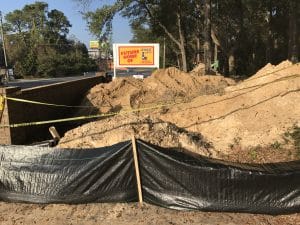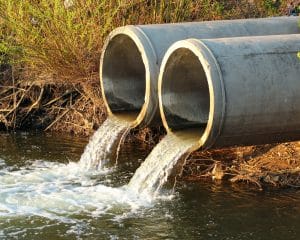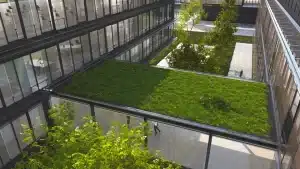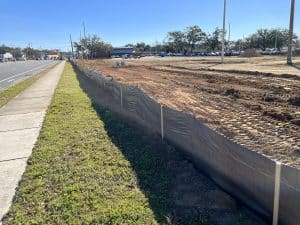Avoid Construction Stormwater Violation Penalties with Effective Runoff Control
Intro
Construction sites can be a significant source of stormwater pollution if proper runoff control measures are not in place. Failure to adhere to construction stormwater regulations can result in costly penalties and fines. In this blog post, we will discuss the importance of effective stormwater runoff control on construction sites to avoid violations and penalties.
Understanding Construction Stormwater Violations and Penalties
When construction sites fail to manage stormwater runoff effectively, they breach regulations designed to protect our water bodies from pollution. Such infractions not only harm the environment but also lead to construction stormwater violation penalties, which can be substantial. The essence of these penalties stems from the need to enforce compliance with laws that safeguard water quality by preventing sediment, chemicals, and debris from construction activities from contaminating nearby rivers, lakes, and streams.
Fines: Violators may be subject to monetary fines imposed by regulatory agencies. The amount of the fine often depends on factors such as the extent of the violation and the potential harm caused to the environment.
STOP Work Orders: Regulatory agencies may issue stop work orders, halting construction activities until the violations are corrected and compliance is achieved.
corrected and compliance is achieved.
Legal Action: In serious cases of non-compliance or repeat violations, regulatory agencies may pursue legal action against violators, which could result in civil or criminal penalties.
Revocation of Permits: Regulatory agencies may revoke permits or approvals issued to the violator, preventing them from continuing construction activities until compliance is achieved.
Overall, construction stormwater violations can have significant financial, legal and reputational consequences for violators, highlighting the importance of adhering to stormwater regulations and best practices.
The scope and scale of these penalties vary widely across different states and jurisdictions. For instance, construction stormwater violation penalties in Florida might differ significantly from those in California, Texas, or Maryland, reflecting the unique environmental priorities and legal frameworks of each state.
This variability underscores the importance for construction site managers and contractors to be acutely aware of the local regulations that govern their projects. Ignorance of the law is not a viable defense, and the financial repercussions of violations can be severe, potentially running into thousands of dollars per day for ongoing non-compliance.
Beyond the immediate financial impact, construction stormwater violations can also result in stop-work orders, hindering project progress and leading to additional indirect costs such as delayed timelines and lost productivity. In more severe cases, companies may face legal action or be required to undertake costly remediation efforts to mitigate the environmental damage caused, further exacerbating the financial strain.
Moreover, repeat violations or egregious disregard for stormwater management regulations can tarnish a company’s reputation, making it difficult to secure future contracts or work in certain jurisdictions. The ripple effects of non-compliance highlight the critical need for diligent stormwater management and adherence to regulatory requirements at all times.
making it difficult to secure future contracts or work in certain jurisdictions. The ripple effects of non-compliance highlight the critical need for diligent stormwater management and adherence to regulatory requirements at all times.
To navigate this complex landscape, construction site managers are encouraged to seek out stormwater inspector training programs and certifications. These educational resources equip individuals with the knowledge to implement compliant stormwater management practices, thereby mitigating the risk of incurring penalties and contributing to the broader goal of environmental protection.
The Environmental Impact of Construction Site Runoff
The repercussions of construction site runoff extend far beyond the boundaries of the construction site itself, leading to a cascade of adverse effects on the surrounding ecosystems and water quality. This stormwater runoff, when not properly managed, carries with it a potent mixture of sediment, pollutants, and debris that can wreak havoc on aquatic ecosystems. Sediment, one of the most common pollutants, can cloud water bodies, reducing oxygen levels and suffocating fish and other aquatic life. This sedimentation can disrupt the natural habitat and breeding grounds of fish, leading to diminished populations and impacting biodiversity.
Beyond sediment, construction runoff can introduce a variety of harmful chemicals into waterways, including pesticides, oil and grease, heavy metals, and other toxic substances that are often used or uncovered during construction activities. These pollutants can have a range of harmful effects on aquatic life, from immediate toxicity to longer-term impacts on reproduction and growth. The alteration of water chemistry can also make water bodies inhospitable for native species, potentially leading to shifts in aquatic ecosystems and reducing their resilience to other stressors.
In addition to direct impacts on water quality and aquatic life, construction site runoff can contribute to the erosion of stream banks and shorelines. This erosion can lead to further habitat loss and increased sedimentation downstream, exacerbating the cycle of degradation. The alteration of natural water flow can also impact the hydrology of the area, affecting not only the aquatic ecosystems but also the terrestrial ecosystems that rely on these water sources. All cities showed increases in average annual stormwater runoff, with changes up to 30% over the next 30 years
The infiltration of pollutants into groundwater presents another significant concern, with the potential to affect drinking water sources and further extend the environmental impact of construction activities beyond immediate water bodies. This underscores the importance of stringent stormwater management practices to protect not only surface water but also the vital groundwater resources.
Addressing these multifaceted impacts requires a comprehensive approach to stormwater management on construction sites, emphasizing the need for strategies that not only prevent runoff but also mitigate the potential for pollution, ensuring the protection of our invaluable water resources and the ecosystems that depend on them.
Best Practices for Stormwater Runoff Control on Construction Sites
According to the Stormwater Training Center, to effectively minimize stormwater runoff at construction sites, it’s critical to implement a set of strategic practices that prioritize erosion and sediment control, along with the reduction of pollutant discharge into water bodies. Key to these efforts is the establishment of physical barriers such as silt fences, sediment basins, and sediment traps, designed to intercept and contain runoff before it exits the site. These barriers act as the first line of defense against sediment transport into adjacent waterways.
traps, designed to intercept and contain runoff before it exits the site. These barriers act as the first line of defense against sediment transport into adjacent waterways.
Equally important is the strategic use of vegetative buffers. These areas of natural or planted vegetation are situated around the perimeter of construction sites and serve to filter out pollutants, slow down water flow, and facilitate the infiltration of runoff back into the soil, reducing the volume of water and pollutants that reach water bodies.
The proper management of construction materials, debris, and waste plays a crucial role in stormwater runoff control. Ensuring that materials are stored correctly and waste is disposed of promptly and appropriately prevents potential contaminants from being washed into water systems during storm events.
Conducting regular site inspections and maintaining stormwater control measures are vital components of an effective management strategy. Regular inspections ensure that all control measures are in optimal condition and functioning as intended, allowing for timely adjustments or repairs to address any deficiencies.
Adopting these best practices not only helps in mitigating the environmental impact of construction activities but also aids in maintaining compliance with regulatory standards, thus avoiding the repercussions of stormwater violations. Through the conscientious application of these measures, construction sites can significantly reduce their contribution to stormwater pollution, playing a crucial role in the preservation of water quality and the protection of aquatic ecosystems.
Innovative Technologies in Stormwater Management
The landscape of stormwater management is evolving rapidly, driven by technological innovation and a growing emphasis on sustainability. Cutting-edge solutions are being developed and deployed to tackle the challenges of controlling construction site runoff more effectively. Among these, permeable pavements stand out for their ability to allow water to pass through, reducing runoff and facilitating groundwater recharge. This technology contrasts traditional impervious surfaces, which exacerbate runoff and pollution.
Green roofs represent another innovative approach, transforming rooftops into vegetated layers that absorb rainwater, thereby reducing runoff and enhancing insulation. This dual function not only mitigates stormwater issues but also contributes to energy efficiency in buildings. Similarly, bio-retention systems, including rain gardens and bioswales, are designed to capture and treat stormwater onsite. These systems utilize soil and plant-based filtration to remove pollutants, mimicking natural processes to improve water quality before it reenters the ecosystem.
reducing runoff and enhancing insulation. This dual function not only mitigates stormwater issues but also contributes to energy efficiency in buildings. Similarly, bio-retention systems, including rain gardens and bioswales, are designed to capture and treat stormwater onsite. These systems utilize soil and plant-based filtration to remove pollutants, mimicking natural processes to improve water quality before it reenters the ecosystem.
Stormwater harvesting systems are gaining traction as a means to capture and store runoff for later use, such as irrigation or toilet flushing. This not only reduces the demand on municipal water supplies but also limits the volume of runoff and pollutants entering waterways. The integration of these technologies into stormwater management plans offers a multifaceted approach to addressing runoff, combining immediate practical benefits with long-term environmental sustainability.
As the construction industry continues to seek out ways to minimize its environmental footprint, these innovative technologies play a pivotal role. They offer practical solutions for managing stormwater runoff more effectively while contributing to the resilience and sustainability of urban infrastructures. Embracing these technologies requires a forward-thinking approach and a willingness to invest in the future of our planet’s water resources.
How to Develop an Effective Stormwater Pollution Prevention Plan (SWPPP)
Creating a robust Stormwater Pollution Prevention Plan (SWPPP) is crucial for managing stormwater at construction sites. This detailed document serves as a blueprint for identifying all potential sources of stormwater pollution and delineates the specific control measures that will be employed to mitigate these risks. The development of an SWPPP requires a systematic approach, beginning with a thorough site assessment to catalog the types of pollutants that could be present and the areas of your construction site most vulnerable to generating runoff.
The next step involves selecting and designing appropriate best management practices (BMPs) tailored to your site’s specific needs. These BMPs might include sediment control measures like silt fences or sediment basins, erosion control strategies such as mulching or the use of erosion control blankets, and other pollution prevention techniques including proper waste management and the use of spill prevention kits.
It’s essential to outline a maintenance plan for these BMPs within your SWPPP to ensure their effectiveness throughout the construction phase. This includes regular inspections, especially before and after significant rain events, to identify and rectify any issues promptly.
Another critical component of the SWPPP is staff training. All personnel should be made aware of the plan’s details, their role in its implementation, and the importance of stormwater management to both compliance and environmental stewardship. This ensures that the practices outlined in the plan are carried out effectively on the ground.
Finally, your SWPPP should include a schedule for monitoring the effectiveness of implemented BMPs and a process for making adjustments as needed. This adaptive management approach allows for the plan to evolve in response to actual site conditions and the efficacy of the selected control measures.
By meticulously developing and adhering to an SWPPP, construction sites can significantly reduce their impact on stormwater quality, ensuring regulatory compliance and demonstrating a commitment to environmental protection.
Case Studies: Successful Stormwater Runoff Control Projects
Exploring real-world examples, numerous construction projects across the nation stand as testaments to the efficacy of implementing comprehensive stormwater runoff control measures. For instance, a major development project in Oregon employed an integrated approach combining green infrastructure with traditional sediment barriers, which significantly minimized the runoff impacts on nearby water bodies. The project’s utilization of bioswales and rain gardens showcased how blending natural landscape features with engineered solutions can provide effective stormwater filtration and absorption, highlighting the project’s innovation and adherence to stringent state regulations.
features with engineered solutions can provide effective stormwater filtration and absorption, highlighting the project’s innovation and adherence to stringent state regulations.
In another example, a large-scale construction project in Maryland embraced advanced erosion control technologies, including high-performance silt fences and erosion control blankets, that surpassed the standard requirements. The project team conducted extensive pre-construction site assessments to identify potential runoff hotspots and implemented targeted strategies accordingly. This proactive approach not only prevented sediment from entering the Chesapeake Bay but also served as a model for future projects in terms of thorough planning and execution.
Down south in Texas, a residential development project faced challenges with stormwater management due to the site’s flat topography and the region’s heavy rainfall patterns. The solution came in the form of a comprehensive stormwater harvesting system, designed to capture runoff for irrigation purposes. This innovative strategy not only mitigated runoff effectively but also conserved water, illustrating the dual benefits of such systems in managing stormwater while contributing to sustainable resource use.
Each of these case studies underscores the importance of tailored stormwater management strategies that account for local environmental conditions, regulatory requirements, and the specific needs of the construction project. By learning from these examples, construction site managers can leverage a mix of innovative and proven techniques to tackle stormwater runoff challenges, ensuring both compliance and environmental protection.
Navigating Construction Stormwater Regulations and Compliance
The landscape of construction stormwater regulations is intricate, marked by a complex web of federal, state, and local mandates that demand rigorous attention from construction site managers and contractors alike. Mastery over these regulations is not just about avoiding penalties but is a crucial part of responsible environmental stewardship and project management. The key to successful navigation lies in a proactive approach, starting with comprehensive research and understanding of the specific legal requirements applicable to the project’s location.
In the United States, the Clean Water Act (CWA) provides the foundational framework for stormwater management, requiring operators of construction sites to obtain a National Pollutant Discharge Elimination System (NPDES) permit if their projects disturb one or more acres of land. These federal requirements are complemented by state-specific regulations, which can vary widely and often include more stringent measures. For example, states like California and Florida have developed robust regulatory frameworks that reflect their unique environmental challenges and priorities. Additionally, local ordinances may introduce another layer of regulatory considerations, further emphasizing the importance of localized knowledge and compliance strategies.
Engaging with construction stormwater inspector training programs offers a strategic avenue for those responsible for managing construction site stormwater to gain in-depth insight into both broad and nuanced regulatory landscapes. These training sessions not only cover the essentials of compliance but also keep participants abreast of the latest regulatory changes and best practices in stormwater management. Certification in this field not only bolsters an individual’s expertise but also enhances a project’s credibility and compliance profile.
Another critical aspect of compliance is the development and implementation of a Stormwater Pollution Prevention Plan (SWPPP), tailored to meet both the project’s specific needs and regulatory obligations. This document should detail all measures to control sediment, erosion, and pollutants from the construction site, ensuring they align with relevant permits and regulations.
To further streamline compliance efforts, many turn to technological solutions and platforms that offer regulatory tracking and compliance assistance. These tools can provide timely updates on regulatory changes, helping construction sites maintain compliance amidst the dynamic nature of stormwater regulations. Engaging with professional associations or environmental consulting firms can also offer guidance and resources tailored to the construction industry’s unique stormwater management challenges.
The Future of Stormwater Management in Construction
As we look ahead, the trajectory of stormwater management within the construction sector is set to be defined by a convergence of innovation, sustainability, and regulatory evolution. The integration of advanced, eco-friendly technologies alongside traditional methods will play a pivotal role in shaping practices that not only comply with evolving regulations but also contribute to the sustainability of our water ecosystems. The emphasis will increasingly shift towards systems that offer dual benefits, such as stormwater harvesting and green infrastructure, which not only mitigate runoff impacts but also enhance urban resilience and water conservation.
The development and adoption of smart, data-driven tools for monitoring and managing stormwater in real-time will further revolutionize how construction projects address runoff. These technologies will provide unprecedented precision in predicting stormwater volumes, tracking sediment transport, and assessing the effectiveness of control measures, facilitating more adaptive and responsive management strategies.
Moreover, regulatory frameworks are expected to grow more comprehensive, pushing for greater innovation and stricter compliance. This will necessitate a deeper engagement and collaboration between construction companies, regulatory bodies, and environmental organizations to develop practical, impactful stormwater management solutions. Training and certification programs will evolve to equip professionals with the knowledge to navigate these changes, emphasizing sustainable practices and the latest technological advancements.
In this forward-looking scenario, the construction industry’s approach to stormwater management will be characterized by a commitment to environmental stewardship, community well-being, and resilience against the challenges posed by climate change and urbanization. Through a collective effort to adopt and refine these emerging trends, the industry can significantly reduce its environmental footprint while paving the way for a more sustainable future.

